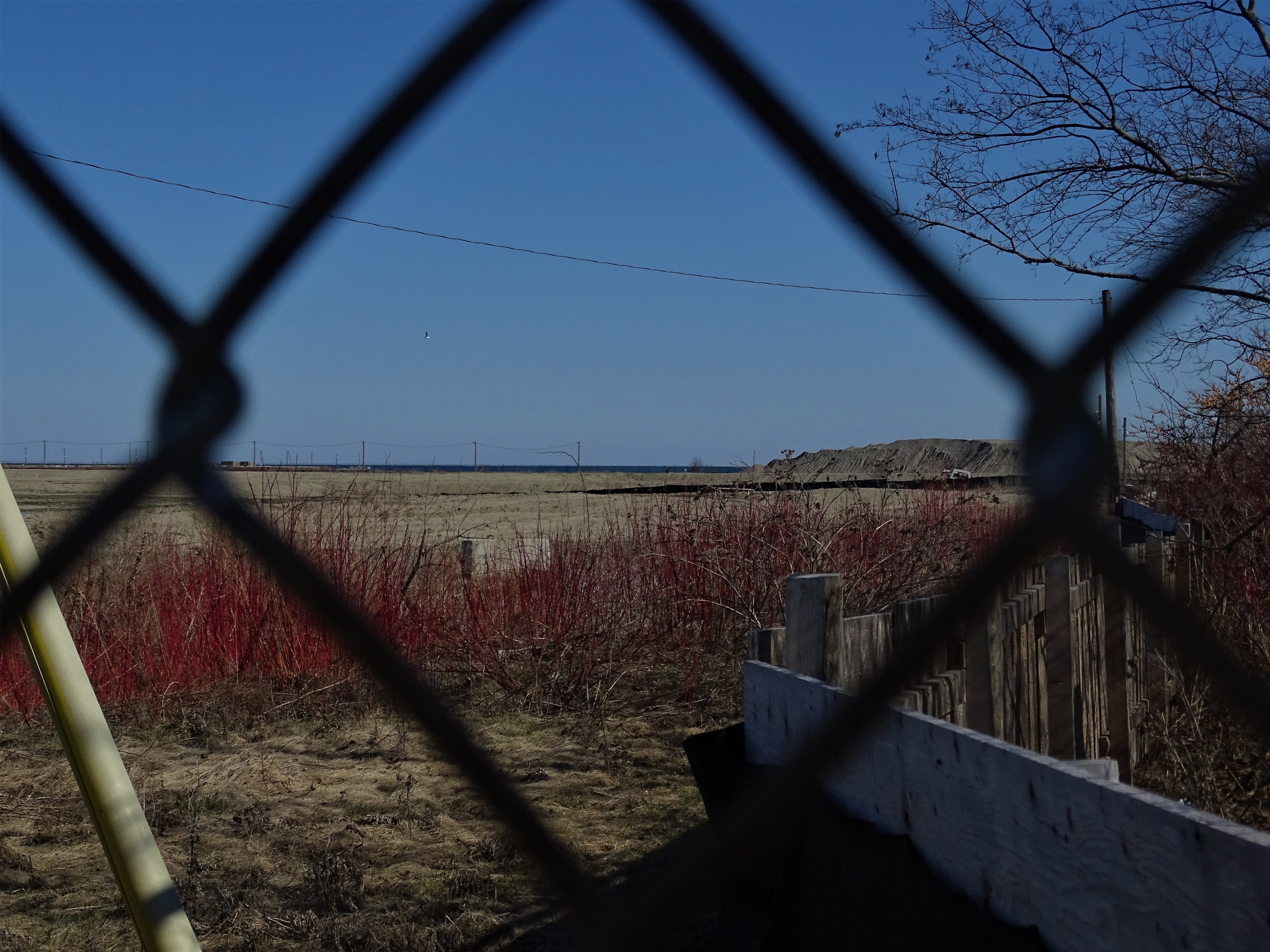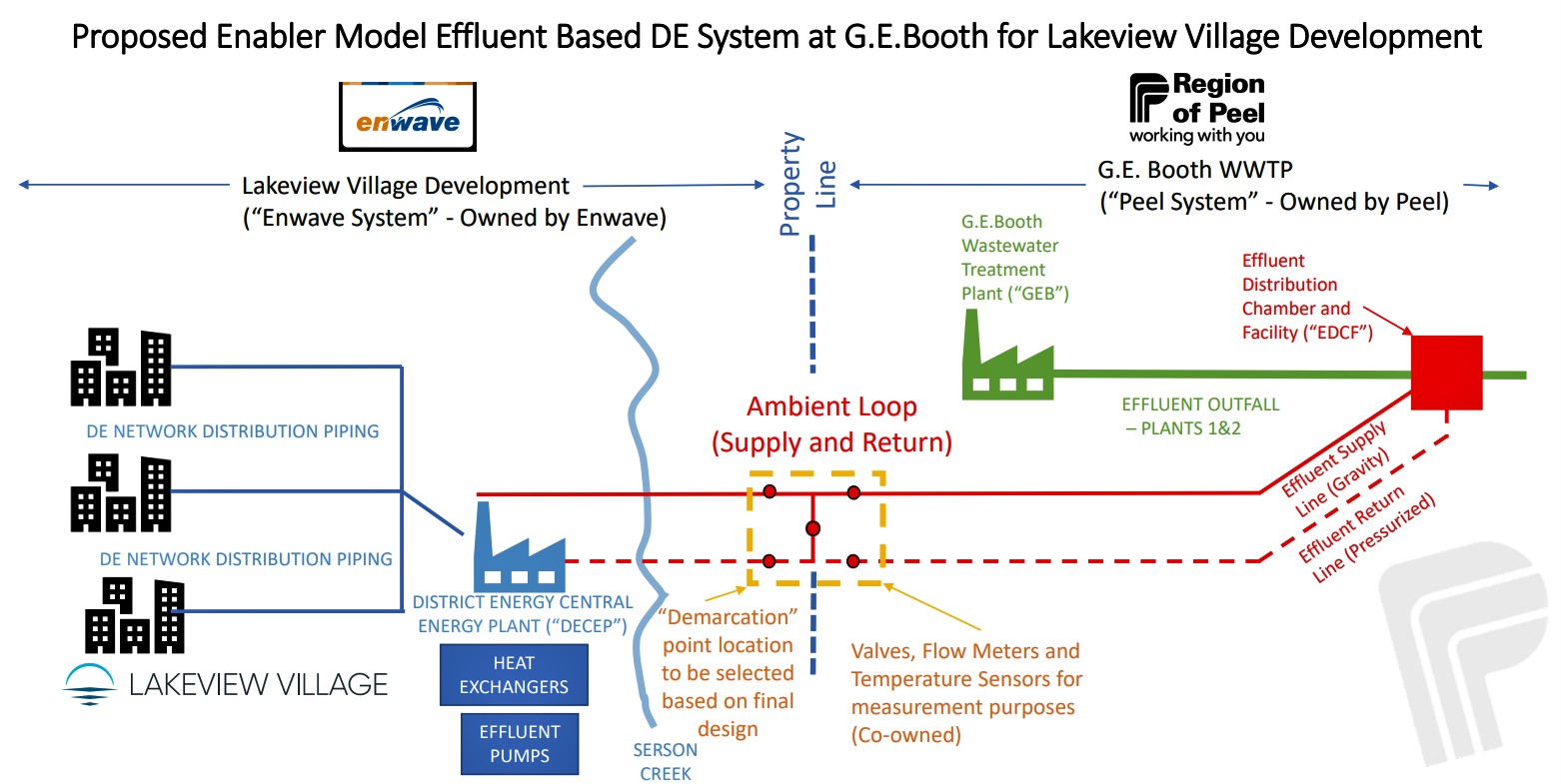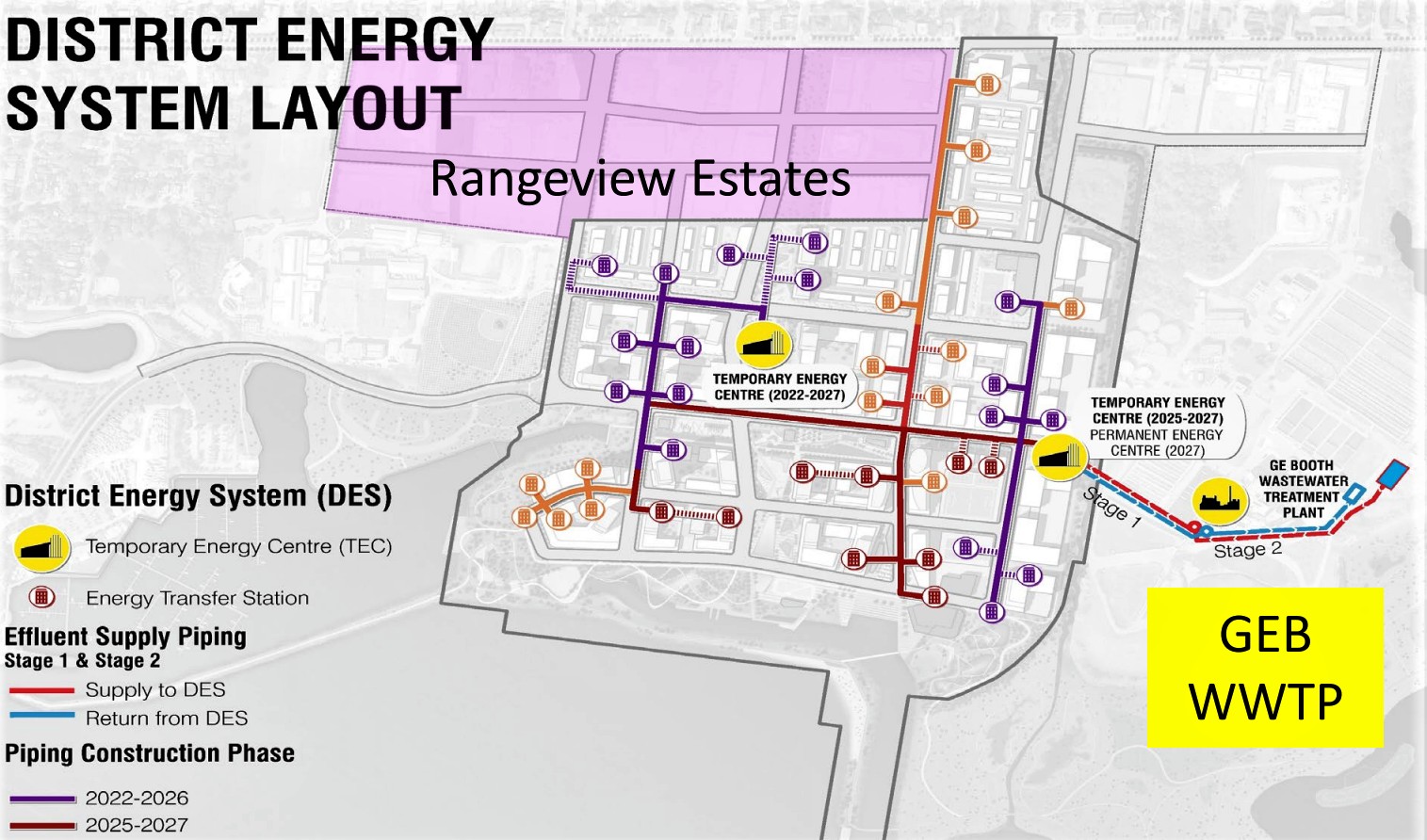
District energy system at Lakeview Village could inch Peel closer to critical climate targets
An innovative plan to heat and cool the future buildings of one of Mississauga’s large development projects could have significant implications for the City’s carbon footprint, at a time when accelerated action is critical in order to meet both Mississauga’s and the Region of Peel’s climate goals.
One of Peel’s largest barriers to achieving effective climate mitigation is its constant growth—both in population and the physical size of its urban footprint. Any action to move the needle and cut greenhouse gas emissions is countered by more residents settling and moving throughout the region.
Without reliable, renewable sources of energy to power continued growth, Peel will miss most of its critical GHG emissions reduction targets. The heat wave that has been smothering much of the GTA this week—and the deadly temperatures that have led to hundreds of deaths in Europe with wildfires burning across the continent—are among the most recent examples of why climate action must be a top priority for elected leaders, at every level.
A planned energy system at Lakeview Village could offer a potential path forward for Peel.
The future Lakeview Village will see 8,000 residential units constructed on 177 acres of Mississauga’s Lake Ontario coastline. A district energy system could drastically reduce the carbon footprint of these units and their future residents. The innovative project is made possible due to a rather unusual neighbour.



Lakeview Village, currently being built on Mississauga's eastern Lake Ontario shoreline, where the old Lakeview power plant sat for decades, is one of the largest waterfront developments in the world.
(LCP/The City of Mississauga)
The future homes at Lakeview will be situated less than 120-metres away from the G.E. Booth Water Resource Recovery Facility, a regional treatment operation that processes and cleans residential wastewater. Until now, the proximity to the facility has raised concerns about how the odour emanating from the treatment plant will impact the quality of life of future residents. The Region of Peel is undertaking a large engineering plan to mitigate any smell, which comes with a price of $9.5 million.
But the proximity of the development comes with a bright side, allowing for the creation of a power plant of sorts that will use the wastewater to heat and cool future homes through a system described as district energy.
It’s a thermal energy process that uses a consistent source, in this case water, to heat and cool buildings. Like geothermal which uses the stored energy of heat beneath the Earth’s surface to warm and cool surrounding buildings, district energy from a water source does the same thing. Think of it as a giant radiator that converts water into steam-heat, or a massive air conditioner that does the same to cool a space. Geothermal systems are used in Metro Vancouver, the City of Markham and Toronto that capture energy from the ground.
Despite the less than ideal odour from the wastewater effluent, the adjacent treatment plant is a perfect piece of infrastructure for a district energy system. The effluent, which is currently cleaned and put back into Lake Ontario, would instead be transferred to a facility that would use the energy to heat and cool buildings in Lakeview Village. A trip to Sweden by late Ward 1 councillor Jim Tovey sparked the idea of such a system using wastewater effluent in the early concept plans for Lakeview Village.
“It can service a number of buildings rather than just one, so rather than each of these buildings needing to have boilers and chillers, you now have a centralized plant that does it for a multitude of buildings,” Anthony Parente, Peel’s general manager water and wastewater, told The Pointer.

From afar, the development is slow moving. In November 2021 the final plan was accepted by council and residents will start seeing more construction in the coming months.
(Natasha O’Neill/The Pointer)
Through a series of underground pipes from G.E. Booth the cleaned wastewater will travel to an Effluent Distribution Chamber and Facility, constructed, maintained and operated by Enwave Energy Corporation. A 2020 estimate by Lakeview Community Partners (LCP)—the conglomerate of developers behind the Lakeview development—estimated the system would cost $35 million. The distribution chamber will take the treated effluent and process it using heat exchangers, pumps and strainers, absorbing the thermal energy.
When the vision for a district energy system was first proposed, the Region was relying on funding from upper levels of government to make it a reality. Without it, the Region and LCP were unable to deliver the system; that was, until June 2021 when Enwave approached the developers with a partnership proposal.
With Enwave’s assistance the project can be fully funded, constructed and maintained by the company operating in conjunction with Peel and LCP.

Peel Region and Enwave will work together to design a system that best suits the community’s needs but the majority of the decisions are made by the private company.
(The Region of Peel)
To complete the district energy loop, Peel’s wastewater system will need to be connected to the future distribution chamber through a series of pipes, work the Region estimates will cost approximately $450,000.
For the Region the list of benefits far outweighs the challenges.
One of the largest benefits will be the reduction in carbon emissions. Heating and cooling are typically done with natural gas across Ontario and Canada, a source that is still a major contributor to GHGs, despite the name. Methane in gas has some characteristics in the atmosphere that are even more harmful than carbon.
The Energy Conservation and Demand Management Plan adopted in 2019 by Regional Council showcases just how high the demand for natural gas in Peel is. Approximately 51 percent of the total natural gas usage in Peel is due to heating residential units. Households switching to electric heating/cooling hoping for a greener alternative should also be wary. An April 2021 staff report on the Climate Change Master Plan indicates the Province will be increasing the use of gas-fired plants as a source of electricity, ultimately making the grid dirtier.
According to the report, if Ontario increases natural gas production and consumption in the Region continues at recent rates, Peel will not be able to achieve its GHG emissions reduction targets.
Peel staff wrote, “the Region’s GHG emissions associated with electricity use increased 59 percent from 2017 to 2018, primarily due to increased natural gas fueled generation in Ontario.”
Similar to oil, liquified “natural” gas is buried deep beneath the Earth’s surface, formed millions of years ago from decaying plant and animal matter placed under extreme heat and pressure. Because it is usually trapped beneath layers of rock, it does not flow easily to the surface. Destructive techniques like fracking are required to extract it. The gas is then transported across the country via pipelines or rail.
Methan is the largest component of natural gas and can be released any time during the process of mining, transportation and electricity generation. Methane is a considerably more potent greenhouse gas than carbon dioxide. For 20 years after reaching the atmosphere, methane has the ability to trap 87 times more heat than the same amount of carbon dioxide, significantly exacerbating the greenhouse effect these gasses create, trapping heat around the earth that increases in temperature like an oven. Cutting methane emissions can have a more impactful, immediate effect, than similar reductions in CO2.
John Stephenson, a former engineer at FVB Energy Inc., a company specializing in district energy systems, says creating more sustainable sources of heating and cooling is much more effective than attempts to retrofit homes with electric heating and cooling.
“When it comes to the crunch, I'm telling you, people will rebel and district energy will be much more affordable,” Stephenson told The Pointer.
He has worked on about 100 plans relating to district energy systems in Canada, of which 90 percent, he estimates, were never built. The feasibility for municipalities to construct the systems without third-party assistance or government support is not realistic.
Before suggesting Peel could construct its own system, Parente, Peel’s general manager water and wastewater, said numerous studies were completed to ensure it was a feasible option. Staff looked at Metro Vancouver’s systems and monitored the systems operational in the City of Markham and the City of Toronto. A number of university campuses, the 2020 Vancouver Olympic Village and portions of Markham's city buildings are also operating successfully with district energy.
“I do want to point out though, these systems that leverage wastewater as a viable source are new to the industry,” Frank Pugliese, contract administration and oversight, water and wastewater for Peel, said. “It's not commonly used as an energy source, so this is innovative.”
Once completed, the system at Lakeview will eliminate an estimated 2,500 to 7,500 tonnes of carbon emissions per year. This reduction will be critical in assisting the Region in achieving its 2050 greenhouse gas (GHG) emission reduction goal. The system will hopefully be fully operational by 2034 once the final build out of Lakeview Village is complete. Parente said this timeline can be moved up if LCP finishes earlier.
As of 2020, Peel was emitting about 93,000 tonnes of CO2 annually. The Region has a goal to reduce 45 percent of emissions below the 2010 levels by 2030, a target that currently has a gap of 17,000 tonnes. If Lakeview Village is completed in 2034, the reduction target of 80 percent below 1990 levels by 2050 will be assisted by the DE system. The City of Mississauga will also benefit from the project as it aims to cut greenhouse gas emissions 40 percent by 2030 and 80 percent below 1990 levels by 2050 with a long-term goal of achieving net-zero.
Along with pushing Peel closer to its climate targets, Parente says the project at Lakeview will also help the region explore innovative ideas to create energy.
“I think environmentally and from a technical standpoint, right now staff believe that there are more opportunities to continue to do this,” he said. “There's a lot more studies needed to make sure we're right on that. We're not going to go and finance staff time until we're convinced one way or another that this is going to be successful.”
Lakeview Village is acting as a pilot project, which Peel will monitor closely to determine if district energy could be implemented elsewhere. Buildings in the region account for the largest source of carbon emissions, with transportation a close second. Mississauga’s own municipal carbon footprint, from its assets, is dominated by pollution caused by its transit system, but City-owned buildings are a significant source as well.
District energy could be a viable option for more developments.
“Through our further studies that we're going to be doing around feasibility for scalability of the district energy systems across Peel, we'll be certainly looking for more opportunities to leverage that because there's a huge community benefit here by enabling future development on low carbon energy sources that don't contribute the GHG emissions,” Parente said.
One concern from Caledon Mayor Allan Thompson was the cost to the residents.
“For the district heating or what you're looking at, what's that costing per unit?” Thompson asked at the June 23 regional council meeting.
“From the point of view of the end user, it's very important that we're creating a system here that the residents or taxpayers are not paying more for their heating and cooling than someone living across the street on Lakeshore [Road],” Brian Sutherland, vice president of Argo development (part of the Lakeview Village development consortium) replied.
With Enwave bearing most of the cost and operational responsibility, Peel will need to construct its own piping for the project. Although the construction price is minimal, maintaining the sub-surface infrastructure will involve more substantial costs over time. Staff believe the maintenance will be cost neutral once the system is functional due to the thermal energy revenue the municipality will receive from Enwave, estimated between $25,000 to $50,000 annually.
“We see this as an incredibly valuable win-win investment for all parties involved. One of our values as a partner is our ability to bring patient capital to long-term infrastructure investment opportunities,” Enwave’s communications spokesperson said, not specifying the direct benefits to the company.
“The Lakeview District Energy project is the first of its kind in Ontario and the largest in Canada. We are proud to contribute our expertise and extensive experience in the sector, working in partnership with municipalities, utilities, and developers to bring to life this vision for a resilient, low-carbon community in Mississauga.”
The approach taken by the municipality is allowing most of the risk and cost to be transferred to the private entity. It also limits the Region’s part in the project including after construction needs like customer service and management of various processes, a similar model to the operation Enwave uses in Toronto and Markham. Support staff will be necessary in the short-term to help with the early phases of the project set-up, which Peel estimates will cost $125,000 to $200,000 per year.

As Lakeview Village is constructed, portions of the district energy system will be complete. Once finished it will heat and cool all the buildings on the property.
(Lakeview Community Partners)
One challenge is the need for the Region of Peel to manage the monitoring system of the wastewater facility that will create the energy, while ensuring no problems arise with wastewater collection and additional changes/upgrades to the system. With Enwave as the owner/operator of the district energy system, Peel will have little control over design and management.
According to staff, the private partnership approach will try to limit risks and challenges to the municipality.
Under the agreement Enwave can terminate the agreement by giving Peel Region 24 months notice.
Hopefully that won’t be the outcome, as Peel and Mississauga look to grow district energy as a viable way to heat and cool municipal infrastructure, while the clock is ticking to dramatically reduce greenhouse gas emissions wreaking havoc on our climate.
Email: [email protected]
Twitter: @taasha__15
COVID-19 is impacting all Canadians. At a time when vital public information is needed by everyone, The Pointer has taken down our paywall on all stories relating to the pandemic and those of public interest to ensure every resident of Brampton and Mississauga has access to the facts. For those who are able, we encourage you to consider a subscription. This will help us report on important public interest issues the community needs to know about now more than ever. You can register for a 30-day free trial HERE. Thereafter, The Pointer will charge $10 a month and you can cancel any time right on the website. Thank you
Submit a correction about this story


